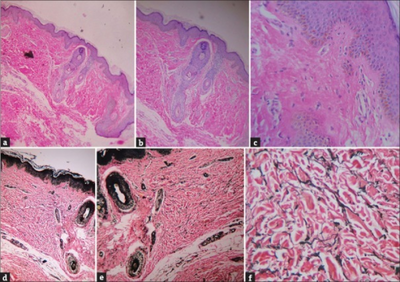De Barsy syndrome
| De Barsy syndrome | |
|---|---|
| Other names: Cutis laxa-corneal clouding-intellectual disability syndrome[1] | |
 | |
| De Barsy syndrome is inherited in an autosomal recessive manner. | |
| Usual onset | Infancy |
De Barsy syndrome is a rare autosomal recessive genetic disorder. Symptoms include cutis laxa (loose hanging skin) as well as other eye, musculoskeletal, and neurological abnormalities.[2] It is usually progressive, manifesting side effects that can include clouded corneas, cataracts, short stature, dystonia, or progeria (premature aging).[3]
It was first described in 1967 by De Barsy et al. and, as of 2011, there have been 27 cases reported worldwide.[4] The genes that cause De Barsy syndrome have not been identified yet,[3] although several studies have narrowed down the symptoms' cause.[5] A study by Reversade et al. (2009) has shown that recessive mutations in PYCR1 or ALD18A1, the genetic sequences that codes for mitochondrial enzymes that synthesize L-proline, are prevalent in cases of autosomal recessive cutis laxa (ARCL), a condition very similar to De Barsy syndrome.[6] [7]A study by Leao-Teles et al. has shown that De Barsy syndrome may be related to mutations in ATP6V0A2 gene, known as ATP6V0A2-CDG by the new naming system.[5]
Alternative names for De Barsy syndrome include corneal clouding-cutis laxa-mental retardation, cutis laxa-growth deficiency syndrome, De Barsy–Moens–Diercks syndrome, and progeroid syndrome of De Barsy.[2]

References
- ↑ INSERM US14. "Orphanet: De Barsy syndrome". www.orpha.net. Archived from the original on 22 October 2012. Retrieved 24 October 2019.
- ↑ 2.0 2.1 "De Barsy Syndrome". Cigna. Archived from the original on 2010-11-21. Retrieved 2011-08-14.
- ↑ 3.0 3.1 Morava E, Guillard M, Lefeber DJ, Wevers RA (September 2009). "Autosomal recessive cutis laxa syndrome revisited". European Journal of Human Genetics. 17 (9): 1099–110. doi:10.1038/ejhg.2009.22. PMC 2986595. PMID 19401719.
- ↑ Kivuva EC, Parker MJ, Cohen MC, Wagner BE, Sobey G (April 2008). "De Barsy syndrome: a review of the phenotype". Clinical Dysmorphology. 17 (2): 99–107. doi:10.1097/MCD.0b013e3282f4a964. PMID 18388779. S2CID 42619228.
- ↑ 5.0 5.1 Leao-Teles E, Quelhas D, Vilarinho L, Jaeken J (May 2010). "De Barsy syndrome and ATP6V0A2-CDG". European Journal of Human Genetics. 18 (5): 526, author reply 526. doi:10.1038/ejhg.2009.218. PMC 2987315. PMID 20010974.
- ↑ Reversade B, Escande-Beillard N, Dimopoulou A, Fischer B, Chng SC, Li Y, et al. (September 2009). "Mutations in PYCR1 cause cutis laxa with progeroid features". Nature Genetics. 41 (9): 1016–21. doi:10.1038/ng.413. PMID 19648921. S2CID 10221927.
- ↑ Fischer-Zirnsak B, Escande-Beillard N, Ganesh J, Tan YX, Al Bughaili M, Lin AE, et al. (September 2015). "Recurrent De Novo Mutations Affecting Residue Arg138 of Pyrroline-5-Carboxylate Synthase Cause a Progeroid Form of Autosomal-Dominant Cutis Laxa". American Journal of Human Genetics. 97 (3): 483–92. doi:10.1016/j.ajhg.2015.08.001. PMC 4564990. PMID 26320891.
External links
| Classification | |
|---|---|
| External resources |
- De Barsy Syndrome Archived 2016-03-09 at the Wayback Machine at the United States National Library of Medicine
- De Barsy Syndrome Archived 2014-08-16 at the Wayback Machine at the National Organization for Rare Disorders